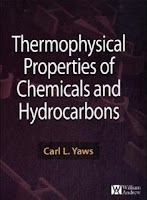C arl Yaws, a leading authority on chemical compounds in the chemical engineering field, has done it again. In his new book -- an essential volume for any chemist or chemical engineer's library -- he presents over 7,800 organic and inorganic chemicals, and hydrocarbons. Spanning gases, liquids and solids, and covering all critical properties (including acentric factor, density, enthalpy of vaporization, and surface tension), this volume represents more properties on more chemicals than any single work of its kind, from C1 to C100 organics and Ac to Zr inorganics. This highly recommended handbook was designed and formatted for field, lab or classroom usage, and gives the reader unparalleled access to invaluable data.
Thermophysical properties for more than 7,800 chemicals and hydrocarbons are presented in this book for temperature dependent properties. Values for enthalpy of vaporization at normal boiling point are provided for more than 22,000 compounds. The comprehensive coverage includes C1 to C100 organics and Ac to Zr inorganics.
The property data are helpful in many engineering and scientific applications:
- Molecular formula - indicates size of molecule, determine groups for group contribution methods to estimate thermodynamic properties.
- Name - identification of compound, helpful in locating safety regulations.
- ***In the tables, an asterisk (*) beside the name of a compound signifies that the name has been shortened to fit the format of the table. To see the full name, refer to the compound by CAS or ID number in chapter one.
- CAS No - Chemical Abstracts Registry Number, useful in specifying compound, helpful in finding MSDS data and locating manufacturers on web.
- Freezing point - useful to determine state at normal conditions - gas, liquid, or solid, helpful in specifying containers for storage and shipping.
- Boiling point - helpful in ascertaining temperatures required for vaporization in process operations, determine separation by distillation, characterize general volatility characteristics.
- Critical temperature - useful in corresponding state correlations for thermodynamic and transport properties.
- Critical pressure - helpful in corresponding state correlations for thermodynamic and transport properties.
- Acentric factor - useful in corresponding state correlations for thermodynamic and transport properties.
- Critical volume - helpful in corresponding state correlations.
- Critical density - useful in corresponding state correlations.
- Critical compressibility factor - helpful in corresponding state correlations.
- Density of liquid - useful in design of storage vessels and shipping containers, useful in many engineering applications involving liquids, helpful in relief valve sizing for safety.
- Density of solid - helpful in design of storage vessels and shipping containers.
- Enthalpy of vaporization - useful in design of vaporizers and condensers, engineering applications involving saturated liquids and vapors, safety engineering such as ascertaining vaporization quantities from vessel rupture.
- Enthalpy of fusion - useful in energy balance calculations.
- Solubility parameter - helpful in vapor-liquid-equilibrium calculations.
- Liquid volume - useful in engineering calculations involving liquids.
- Van der waals area and volume - helpful in molecular thermodynamics.
- Radius of gyration - useful in molecular thermodynamics.
- Dipole moment - helpful in corresponding state correlations for polar compounds.
- Surface tension - useful in heat and mass transfer correlations.
Thermophysical Properties of Chemicals and Hydrocarbons
Publisher:William Andrew Publishing | ISBN: 0815515960 | 2008-06-23 | 800 pages | 104 MB | PDF | Rapidshare&Hotfile
Download Links :
or





